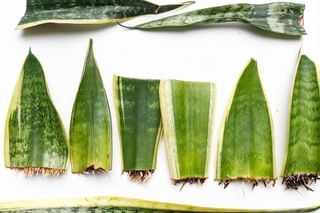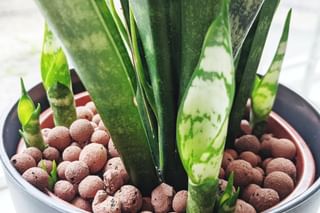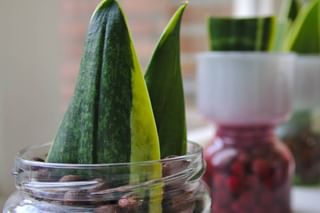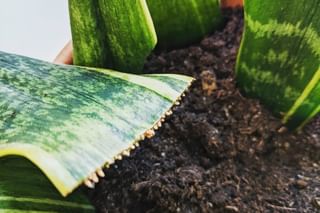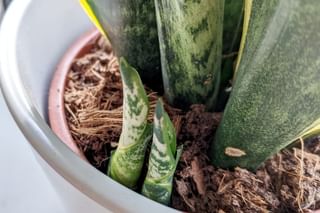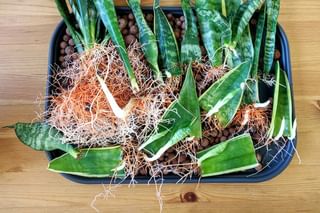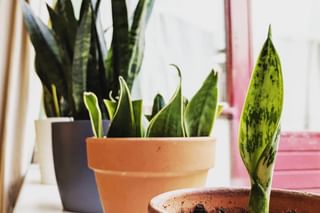How to propagate a Sansevieria (Snake plant)
In this plant care guide, we're going to look at how you can propagate your Sansevieria (Snake plant) and give it the best chance to help it grow into an adult plant. We're going to look at different ways to propagate and different growing mediums to help you achieve success.
Sansevierias are strange, but cool, looking plants that are easy to propagate. There are 2 easy ways to propagate a Sansevieria, both of which we'll look at in this plant care guide. After we've looked at both of these ways to propagate your Sansevieria, you'll know which one is easiest for you and your plant.
In this plant care guide, we're going to look at:
- Propagation by plant division
- Propagating leaf cuttings
- Choosing a growing medium
- Propagating in Soil
- Propagation in Leca
Both of the ways to propagate your Sansevieria are great ways and they'll both help your cutting to grow up to be amazing, fully-grown plant. To get started, I'll explain what these two different ways of propagation means. First, we'll look at plant division, as that's the safest and easiest way to propagate your snake plant.
Let's get started!
Propagating a Sansevieria through plant division
The first way to propagate your Sansevieria, is propagation through division. Propagation by plant division means that you wait for your parent plant to grow baby plants like in the picture above. These baby plants grow out of the parent plant, which means they don't feed themselves yet. These baby plants grow really quickly, so if you're patient, you'll have quite a big plant to put in a new pot already.
When you want to propagate this baby plant, you'll have to cut it off the parent plant with a pair of scissors or a knife. After you've cut the baby plant off the parent plant, you'll see that the part that was connected to the parent is moist. Before you put this cutting in the soil or Leca, you'll need to let it dry for 2 days.
When you let the cutting dry, you protect your baby plant against pests and diseases. After these 2 days, the baby plant should be dry and you can put it in your growing medium, ether that's soil or something else.
When you're doing propagation through division, you'll have the added benefit that your baby plant will likely already have several roots. This is important, because this will make it much easier to take care of your new plant. We'll look at more of that in the next section.
Propagating a Sansevieria through leaf cuttings

The second way to propagate your Sansevieria, is to propagate its leaves. This means that you take one (or more) of the leaves of the parent plant and cut it off the plant. Cutting it's leaves off sounds worse than it actually is. A Sansevieria stores a lot moisture in its leaves, which means that you can propagate these leaves. This is very much like propagating a succulent. Your cutting uses the moisture it has in its leaves to grow roots and keep itself healthy.
But it gets better! Sansevieria leaves are quite long, so you can even cut these leaves into smaller pieces. When you do this, you can grow more Sansevierias from a single leaf. But cutting the leaf into smaller pieces doesn't come without risk. When you propagate a whole leaf, it has quite a lot of nutrients that will help it stay healthy for several months. However, if you cut the leaves into smaller sections, you need to do everything right to help your plant grow roots more quickly. When you cut the leaves into smaller pieces, you risk losing the leaves. That's why I wouldn't recommend that you do this for your first propagation experience.
After you've cut the leaf off the parent plant, you'll need to let the leaf dry for 2 days. This has the same reason for when you're propagating it through plant division. When you let the leaf dry for 2 days, the cut wound will have dried. If the leaf is not dry when you plant it in soil or leca, it's likely to get infected with a disease. Luckily, when you see this infection, you can cut this part off the bottom of the leaf and try again.
Choosing a growing medium
Now that you've cut your baby plant or leaf off the parent plant and let it dry for 2 days, it's time to choose a growing medium for it. Like most other plants, you can propagate your cuttings into many different growing mediums.
In this guide, we're going to look at growing your Sansevieria cuttings in soil and Leca. You could grow your cuttings in water as well if you want to. I won't cover water propagation for a Sansevieria, because this isn't a long-term solution. When you propagate your cutting in water, you'll have to move it to soil or Leca as soon as you get some roots anyway. That's why I explain starting in soil and Leca from the start.
First, we'll look at propagating your cuttings in soil and then we'll look at Leca. I'm including Leca here, because this is how I personally propagate all of my Sansevierias and I love to share my experience.
Propagating a Sansevieria in soil
Propagating your Sansevieria cuttings in soil is a great way to help them grow roots and feed them along the way. When you want to grow your cuttings in soil, there are a few things that you need to keep in mind.
Watering a Sansevieria cutting in soil
Watering your cuttings, when they're planted in soil, is very different from watering fully-grown Sansevierias. When your cuttings don't have any roots yet, they won't absorb any moisture from the soil. This means that the soil stays moist for much longer than you're used to. If you've read "How to care for Sansevierias" you'll know that Sansevierias don't do well in moist environments and want to be in dry soil. When the soil is moist for a long period of time, the Sansevieria leaf could start to rot at the bottom. If this happens, you can simply cut this part off, let your leaf dry again for 2 days, and try again.
It's very important to water your cuttings very little until they have roots. Once they have roots, they can absorb moisture from the soil and you can water them like you would a fully-grown Sansevieria.
Pot size for your Sansevieria cutting in soil
Another thing you need to keep in mind is the pot size for your Sansevieria cuttings. A bigger pot means more soil. More soil means that it will stay moist for much longer than when you water a small pot. When you're first planting your cuttings in soil, make sure to plant it in a pot that allows the soil to dry out quickly. Another reason to pick a small pot is that your Sansevieria loves to be root bound. When your plant can take over the whole pot, it promotes growth.
Propagating a Sansevieria in Leca
Now that we've seen the challenges you have to overcome when you're using soil to grow your Sansevieria cuttings, we'll have a look at Leca. Leca is amazing for plants that like to dry out and it helps you to water your plants consistently. These advantages are great for fully-grown Sansevierias, but also for its cuttings.
Since Leca helps you to water your plants more consistently, it's great for planting your cuttings in. The hard clay balls allow plenty of oxygen and moisture to reach the Sansevieria's roots. When you're using Leca, your cuttings won't be exposed to a lot of moisture, which is great to avoid any rotting due to overwatering.
When the cuttings start to grow roots, these roots will need to grow longer to find the moisture in the clay balls. This promotes growth and help your cuttings to grow roots much more quickly. Your cuttings in soil will have moisture available anywhere in the pot, so it doesn't have to grow these roots as quickly to find the moisture.
Watering your Sansevieria cutting in Leca
The biggest challenge you have to think about when growing your Sansevieria cutting in Leca is watering it. The Leca does a good job of distributing the moisture to the plant, but you have to make sure the cutting itself is never sitting in the water. When your cutting is sitting in water for too long, you could risk it rotting.
Conclusion
You can propagate your Sansevieria through plant division and leaf cuttings. Each of these has its advantages and disadvantages, but you can make it as easy or as difficult as you want. The easiest way to propagate your Sansevieria is to propagate by plant division and plant your baby Sansevieria in Leca. This way, you're not putting your plant at a lot of risk of overwatering and you're promoting growth because your plant has to look for the moisture. However, this is not the only way and there are other great ways to propagate your Sansevieria.
Thank you for reading this post! I hope it helps you to keep your plants healthy and beautiful! If you're looking for more guides on specific plants, you can always request a plant guide to get a guide for the plant you have trouble with.
Test your plant care knowledge
Quiz completed!
Want to learn more? Sign up for my newsletter to receive free tips in your inbox!
Sign up now!